Self-Healing, Solvent-Free, Anti-Corrosion Coating Based on Skin-like Polyurethane/Carbon Nanotubes Composites with Real-Time Damage Monitoring
Abstract
1. Introduction
2. Experimental Methods
2.1. Materials
2.2. Preparation of SFPUHE-HTF and SFPUHE-HTF-CNT Coatings
2.3. Characterization
3. Results and Discussion
3.1. Fabrication and Structural Characterization of SFPUHE-HTF and SFPUHE-HTF-CNTs
3.2. Self-Repair Performance and Repair Mechanism of SFPUHE-HTF and SFPUHE-HTF-CNTs
3.3. Anti-Corrosive Properties of SFPUHE-HTF-CNTs
3.4. Sensing Performance of SFPUHE-HTF-CNTs and Its Application in Real-Time Damage Monitoring
4. Conclusions
Supplementary Materials
Author Contributions
Funding
Data Availability Statement
Conflicts of Interest
References
- Li, G.; Fang, H.; Hu, Y.; Chen, X.; Chu, Z.; Yang, Z. Construction of vinyl ester resins composite coatings via introducing silane-functionalized graphene oxide for enhancing comprehensive performance. Compos. Sci. Technol. 2022, 228, 109670. [Google Scholar] [CrossRef]
- Nagai, T.; Hiratsuka, M.; Alanazi, A.; Nakamori, H.; Hirakuri, K. Anticorrosion of DLC coating in acid solutions. Appl. Surf. Sci. 2021, 552, 149373. [Google Scholar] [CrossRef]
- Yan, H.; Li, J.; Zhang, M.; Zhao, Y.; Feng, Y.; Zhang, Y. Enhanced corrosion resistance and adhesion of epoxy coating by two-dimensional graphite-like g-C3N4 nanosheets. J. Colloid Interface Sci. 2020, 579, 152–161. [Google Scholar] [CrossRef] [PubMed]
- Luo, X.; Qin, R.; Feng, J.; Zhang, P.; Wang, W.; Ren, H.; Kong, H.; Hu, W. Robust, Superhydrophobic, and Self-Healing Films with Hierarchical Nacre Mimetics: A High-Efficiency and “Green” Route Based on Solvent-Free Polyurethane/Modified Graphene Oxide Composites. Macromol. Mater. Eng. 2022, 307, 2200127. [Google Scholar] [CrossRef]
- Dehghani, A.; Gargari, M.Z.; Majd, M.T. Development of a nanocomposite coating with anti-corrosion ability using graphene oxide nanoparticles modified by Echium ammonium extract. Prog. Org. Coat. 2022, 166, 106778. [Google Scholar] [CrossRef]
- Yi, H.; Deng, Y.; Wang, C. Pickering emulsion-based fabrication of epoxy and amine microcapsules for dual core self-healing coating. Compos. Sci. Technol. 2016, 133, 51–59. [Google Scholar] [CrossRef]
- Fan, W.; Zhang, Y.; Li, W.; Wang, W.; Zhao, X.; Song, L. Multi-level self-healing ability of shape memory polyurethane coating with microcapsules by induction heating. Chem. Eng. J. 2019, 368, 1033–1044. [Google Scholar] [CrossRef]
- Fu, X.; Du, W.; Dou, H.; Fan, Y.; Xu, J.; Tian, L.; Zhao, J.; Ren, L. Nanofiber Composite Coating with Self-Healing and Active Anticorrosive Performances. ACS Appl. Mater. Interfaces 2021, 13, 57880–57892. [Google Scholar] [CrossRef]
- Zhu, Y.; Chen, M.; Wu, L. Synthesis of UV-Responsive Dual-Functional Microspheres for Highly Efficient Self-Healing Coatings. Chem. Eng. J. 2021, 422, 130034. [Google Scholar] [CrossRef]
- Dong, F.; Yang, X.; Guo, L.; Wang, Y.; Shaghaleh, H.; Huang, Z.; Xu, X.; Wang, S.; Liu, H. Self-healing polyurethane with high strength and toughness based on a dynamic chemical strategy. J. Mater. Chem. A 2022, 10, 10139–10149. [Google Scholar] [CrossRef]
- Jing, T.; Heng, X.; Guifeng, X.; Li, L.; Li, P.; Guo, X. Rapid self-healing and tough polyurethane based on the synergy of multi-level hydrogen and disulfide bonds for healing propellant microcracks. Mater. Chem. Front. 2022, 6, 1161–1171. [Google Scholar] [CrossRef]
- Wang, X.; Liang, D.; Cheng, B. Preparation and research of intrinsic self-healing elastomers based on hydrogen and ionic bond. Compos. Sci. Technol. 2020, 193, 108127. [Google Scholar] [CrossRef]
- Zhang, J.; Zhang, C.; Song, F.; Shang, Q.; Hu, Y.; Jia, P.; Liu, C.; Hu, L.; Zhu, G.; Huang, J.; et al. Castor-oil-based, robust, self-healing, shape memory, and reprocessable polymers enabled by dynamic hindered urea bonds and hydrogen bonds. Chem. Eng. J. 2022, 429, 131848. [Google Scholar] [CrossRef]
- Ouyang, H.; Li, X.; Lu, X.; Xia, H. Selective Laser Sintering 4 D Printing of Dynamic Cross-linked Polyurethane Containing Diels-Alder Bonds. ACS Appl. Polym. Mater. 2022, 4, 4035–4046. [Google Scholar] [CrossRef]
- Ying, W.B.; Wang, G.; Kong, Z.; Yao, C.K.; Wang, Y.; Hu, H.; Li, F.; Chen, C.; Tian, Y.; Zhang, J.; et al. A Biologically Muscle-Inspired Polyurethane with Super-Tough, Thermal Reparable and Self-Healing Capabilities for Stretchable Electronics. Adv. Funct. Mater. 2021, 31, 2009869. [Google Scholar] [CrossRef]
- Ratwani, C.R.; Kamali, A.R.; Abdelkader, A.M. Self-healing by Diels-Alder cycloaddition in advanced functional polymers: A review. Prog. Mater. Sci. 2023, 131, 101001. [Google Scholar] [CrossRef]
- Zhang, X.; Chen, P.; Zhao, Y.; Liu, M.; Xiao, Z. High-Performance Self-Healing Polyurethane Binder Based on Aromatic Disulfide Bonds and Hydrogen Bonds for the Sulfur Cathode of Lithium-Sulfur Batteries. Ind. Eng. Chem. Res. 2021, 60, 12011–12020. [Google Scholar] [CrossRef]
- Zheng, T.; Zhou, Q.; Yang, T.; Zhao, Y.; Fan, B.; Bo, J.; Fan, L.; Peng, R. Disulfide bond containing self-healing fullerene derivatized polyurethane as additive for achieving efficient and stable perovskite solar cells. Carbon 2022, 196, 213–219. [Google Scholar] [CrossRef]
- Kim, S.M.; Jeon, H.; Shin, S.H.; Park, S.A.; Jegal, J.; Hwang, S.Y.; Oh, D.X.; Park, J. Superior Toughness and Fast Self-Healing at Room Temperature Engineered by Transparent Elastomers. Adv. Mater. 2018, 30, 1705145. [Google Scholar] [CrossRef]
- Sun, J.; Duan, J.; Liu, X.; Dong, X.; Zhang, Y.; Liu, C.; Hou, B. Environmentally benign smart self-healing silicone-based coating with dual antifouling and anti-corrosion properties. Appl. Mater. Today 2022, 28, 101551. [Google Scholar] [CrossRef]
- Liu, S.; Li, Z.; Yu, Q.; Qi, Y.; Peng, Z.; Liang, J. Dual self-healing composite coating on magnesium alloys for corrosion protection. Chem. Eng. J. 2021, 424, 130551. [Google Scholar] [CrossRef]
- Joo, S.J.; Yu, M.H.; Kim, W.S.; Kim, H.S. Damage detection and self-healing of carbon fiber polypropylene (CFPP)/carbon nanotube (CNT) nano-composite via addressable conducting network. Compos. Sci. Technol. 2018, 167, 62–70. [Google Scholar] [CrossRef]
- Wei, J.; Sun, L.; Han, J.; Huang, W. MWCNTs/CB waterborne conductive smart coating for damage monitoring of composites: Design, fabrication, characterization, and verification. Prog. Org. Coat. 2022, 172, 107136. [Google Scholar] [CrossRef]
- Qureshi, Y.; Tarfaoui, M.; Lafdi, K.K.; Lafdi, K. Real-time strain monitoring and damage detection of composites in different directions of the applied load using a microscale flexible Nylon/Ag strain sensor. Struct. Health Monit. 2019, 19, 885–901. [Google Scholar] [CrossRef]
- Guo, Y.; Yang, L.; Zhang, L.; Chen, S.; Sun, L.; Gu, S.; You, Z. A Dynamically Hybrid Crosslinked Elastomer for Room-Temperature Recyclable Flexible Electronic Devices. Adv. Funct. Mater. 2021, 31, 2106281. [Google Scholar] [CrossRef]
- Wu, H.; Tian, M.; Zhang, L.; Tian, H.; Wu, Y.; Ning, N.; Chan, T.W. New Understanding of Morphology Evolution of Thermoplastic Vulcanizate (TPV) during Dynamic Vulcanization. ACS Sustain. Chem. Eng. 2014, 3, 26–32. [Google Scholar] [CrossRef]
- Li, H.; Sinha, T.K.; Oh, J.S.; Kim, J.K. Soft and Flexible Bilayer Thermoplastic Polyurethane Foam for Development of Bioinspired Artificial Skin. ACS Appl. Mater. Interfaces. 2018, 10, 14008–14016. [Google Scholar] [CrossRef]
- Chambers, E.S.; Stejic, M.V. Skin barrier immunity and ageing. Immunology 2020, 160, 116–125. [Google Scholar] [CrossRef]
- Islam, M.H.; Afroj, S.; Uddin, M.A.; Andreeva, D.V.; Novoselov, K.S.; Karim, N. Graphene and CNT-Based Smart Fiber-Reinforced Composites: A Review. Adv. Funct. Mater. 2022, 32, 2205723. [Google Scholar] [CrossRef]
- Liu, J.; Chen, Z.; Hu, C.; Yang, W.; Wang, J.; Xu, W.; Wang, Y.; Ruan, C.; Luo, Y. Fluorescence visualization directly monitors microphase separation behavior of shape memory polyurethanes. Appl. Mater. Today 2021, 23, 100986. [Google Scholar] [CrossRef]
- Xiao, Y.; Jiang, L.; Liu, Z.; Yuan, Y.; Yan, P.; Zhou, C.; Lei, J. Effect of phase separation on the crystallization of soft segments of green waterborne polyurethanes. Polym. Test. 2017, 60, 160–165. [Google Scholar] [CrossRef]
- Xu, Q.; Liu, Y.; Chen, Y.; Zhang, Z.; Wei, Y.Y. Preparation and properties of Joule thermal effect self-healing polyurethane. Carbon Lett. 2021, 32, 217–228. [Google Scholar] [CrossRef]
- Xu, Y.; Chen, D. A Novel Self-Healing Polyurethane Based on Disulfide Bonds. Macromol. Chem. Phys. 2016, 217, 1191–1196. [Google Scholar] [CrossRef]
- Wang, T.; Yu, W.C.; Zhou, C.G.; Sun, W.J.; Zhang, Y.P.; Jia, L.C.; Gao, J.F.; Dai, K.; Yan, D.X.; Li, Z.M. Self-healing and flexible carbon nanotube/polyurethane composite for efficient electromagnetic interference shielding. Compos. Part B Eng. 2020, 193, 108015. [Google Scholar] [CrossRef]
- Hamdan, S.; Pastar, I.; Drakulich, S.; Dikici, E.; Canic, M.T.; Deo, S.; Daunert, S. Nanotechnology-Driven Therapeutic Interventions in Wound Healing: Potential Uses and Applications. ACS Cent. Sci. 2017, 3, 163–175. [Google Scholar] [CrossRef]
- Li, T.; Zhang, Z.P.; Rong, M.Z.; Zhang, M.Q. Self-healable and thiol-ene UV-curable waterborne polyurethane for anticorrosion coating. J. Appl. Polym. Sci. 2019, 136, 47700. [Google Scholar] [CrossRef]
- Rashmi, E.V.; Vijayalakshmi, K.P.; Balachandran, N.; Mathew, D.; Santhosh Kumar, K.S. Soft-segment Free Polyurethanes and their Self-healable Films. Prog. Org. Coat. 2020, 146, 105709. [Google Scholar] [CrossRef]
- Zhao, D.; Du, Z.; Liu, S.; Wu, Y.; Guan, T.; Sun, Q.; Sun, N.; Ren, B. UV Light Curable Self-Healing Superamphiphobic Coatings by Photopromoted Disulfide Exchange Reaction. ACS Appl. Polym. Mater. 2019, 1, 2951–2960. [Google Scholar] [CrossRef]
- Ling, W.; Mo, F.; Wang, J.; Liu, Q.; Liu, Y.; Yang, Q.; Qiu, Y.; Huang, Y. Self-healable hydrogel electrolyte for dendrite-free and self-healable zinc-based aqueous batteries. Mater. Today Phys. 2021, 20, 100458. [Google Scholar] [CrossRef]
- Cheng, B.; Lu, X.; Zhou, J.; Qin, R.; Yang, Y. Dual Cross-Linked Self-Healing and Recyclable Epoxidized Natural Rubber Based on Multiple Reversible Effects. ACS Sustain. Chem. Eng. J. 2019, 7, 4443–4455. [Google Scholar] [CrossRef]
- Zhang, E.; Liu, X.; Liu, Y.; Shi, J.; Li, X.; Xiong, X.; Xu, C.; Wu, K.; Lu, M. Highly stretchable, bionic self-healing waterborne polyurethane elastic film enabled by multiple hydrogen bonds for flexible strain sensors. J. Mater. Chem. A 2021, 9, 23055–23071. [Google Scholar] [CrossRef]
- Coleman, M.M.; Lee, K.H.; Skrovanek, D.J.; Painter, P.C. Hydrogen bonding in polymers. 4. Infrared temperature studies of a simple polyurethane. Macromolecules 2002, 19, 2149–2157. [Google Scholar] [CrossRef]
- Coleman, M.M.; Skrovanek, D.J.; Hu, J.; Painter, P.C. Hydrogen bonding in polymer blends. 1. FTIR studies of urethane-ether blends. Macromolecules 2002, 21, 59–65. [Google Scholar] [CrossRef]
- Mondragon, G.; Santamaria-Echart, A.; Hormaiztegui, M.E.V.; Peña-Rodriguez, C.; Mucci, V.; Corcuera, M.; Arbelaiz, M.I.; Eceiza, A. Nanocomposites of Waterborne Polyurethane Reinforced with Cellulose Nanocrystals from Sisal Fibres. J. Polym. Environ. 2018, 26, 1869–1880. [Google Scholar] [CrossRef]
- Lin, D.; Zeng, X.; Li, H.; Lai, X. Facile fabrication of superhydrophobic and flame-retardant coatings on cotton fabrics via layer-by-layer assembly. Cellulose 2018, 25, 3135–3149. [Google Scholar] [CrossRef]
- Zhao, R.; Chen, Y.; Liu, G.; Jiang, Y.; Chen, K. Fabrication of self-healing waterbased superhydrophobic coatings from POSS modified silica nanoparticles. Mater. Lett. 2018, 229, 281–285. [Google Scholar] [CrossRef]
- Habibpour, S.; Um, J.G.; Jun, Y.; Bhargava, P.; Park, C.B.; Yu, A. Structural Impact of Graphene Nanoribbon on Mechanical Properties and Anti-corrosion Performance of Polyurethane Nanocomposites. Chem. Eng. J. 2021, 405, 126858. [Google Scholar] [CrossRef]
- Cui, S.; Wang, J.; Mi, L.; Chen, K.; Ai, W.; Zhai, L.; Guan, X.; Zheng, Y.; Wang, D. A new synergetic system based on triboelectric nanogenerator and corrosion inhibitor for enhanced anticorrosion performance. Nano Energy 2022, 91, 106696. [Google Scholar] [CrossRef]
- Li, D.W.; Wang, H.Y.; Liu, Y.; Wei, D.S.; Zhao, Z.X. Large-scale fabrication of durable and robust super-hydrophobic spray coatings with excellent repairable and anti-corrosion performance. Chem. Eng. J. 2019, 367, 169–179. [Google Scholar] [CrossRef]
- Um, J.G.; Habibpour, S.; Jun, Y.-S.; Elkamel, A.; Yu, A. Development of π–π interaction-induced functionalized graphene oxide on mechanical and anticorrosive properties of reinforced polyurethane composites. Ind. Eng. Chem. Res. 2020, 59, 3617–3628. [Google Scholar] [CrossRef]
- Zhang, M.; Li, C.; Wang, X.; Peng, J.; Yuan, S.; Geng, H.; Zhou, Y.; Gao, Y.; Wang, H. Ultrahigh anti-corrosion performance of polymer-bsed coating filled with a novel micro network nanofiller. Corros. Sci. 2021, 190, 109685. [Google Scholar] [CrossRef]
- Qi, X.; Zhang, D.; Ma, Z.; Cao, W.; Hou, Y.; Zhu, J.; Gan, Y.; Yang, M. An Epidermis-like Hierarchical Smart Coating with a Hardness of Tooth Enamel. ACS Nano 2018, 12, 1062–1073. [Google Scholar] [CrossRef] [PubMed]
- Romate, X.F.S.; Moriche, R.; Suárez, A.J.; Sánchez, M.; Prolongo, S.G.; Güemes, A.; Ureña, A. Highly sensitive strain gauges with carbon nanotubes: From bulk nanocomposites to multifunctional coatings for damage sensing. Appl. Surf. Sci. 2017, 424, 213–221. [Google Scholar] [CrossRef]
- Wu, T.; Chen, B. Autonomous self-healing multiwalled carbon nanotube nanocomposites with piezoresistive effect. RSC Adv. 2017, 7, 20422–20429. [Google Scholar] [CrossRef]

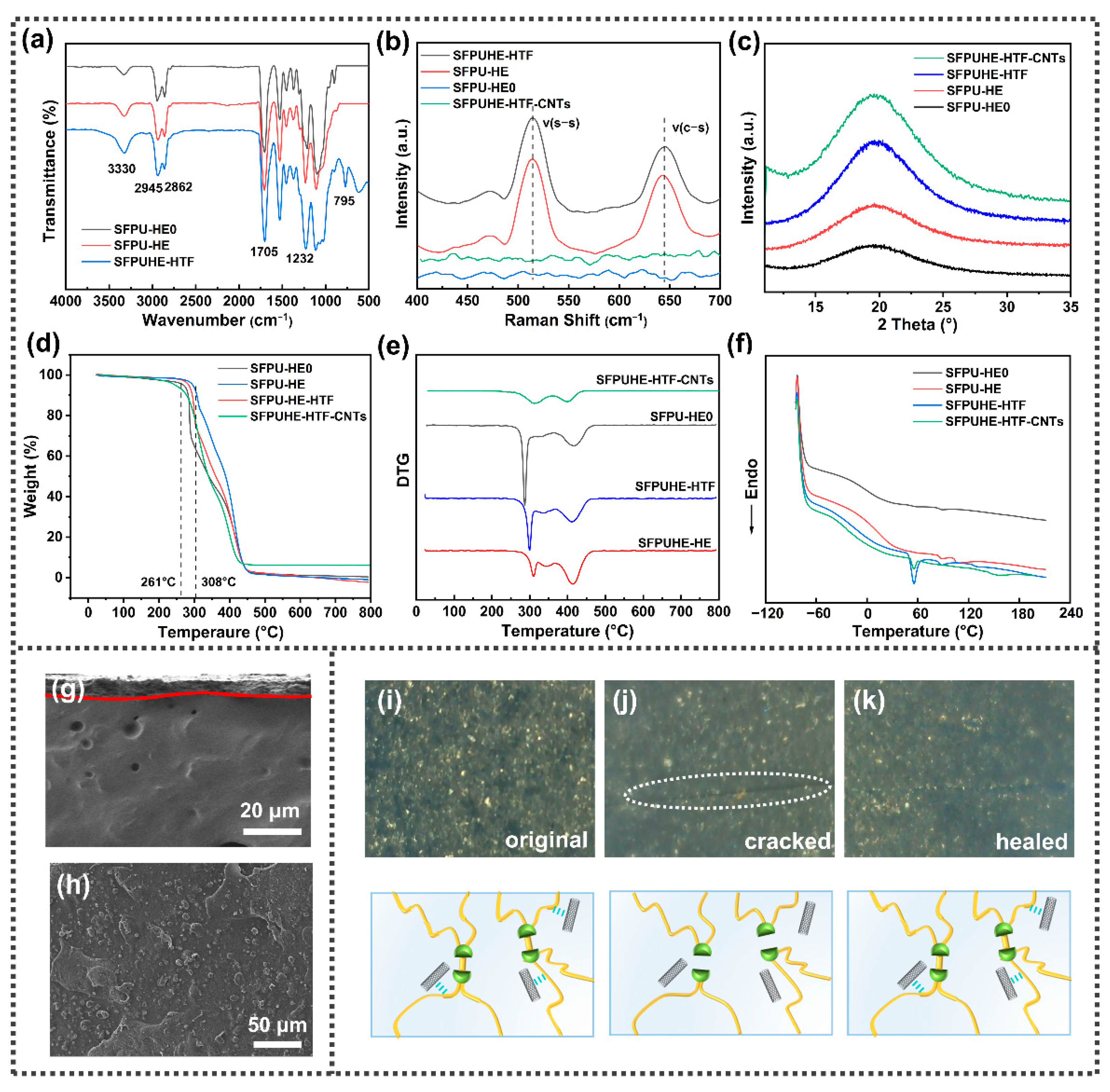
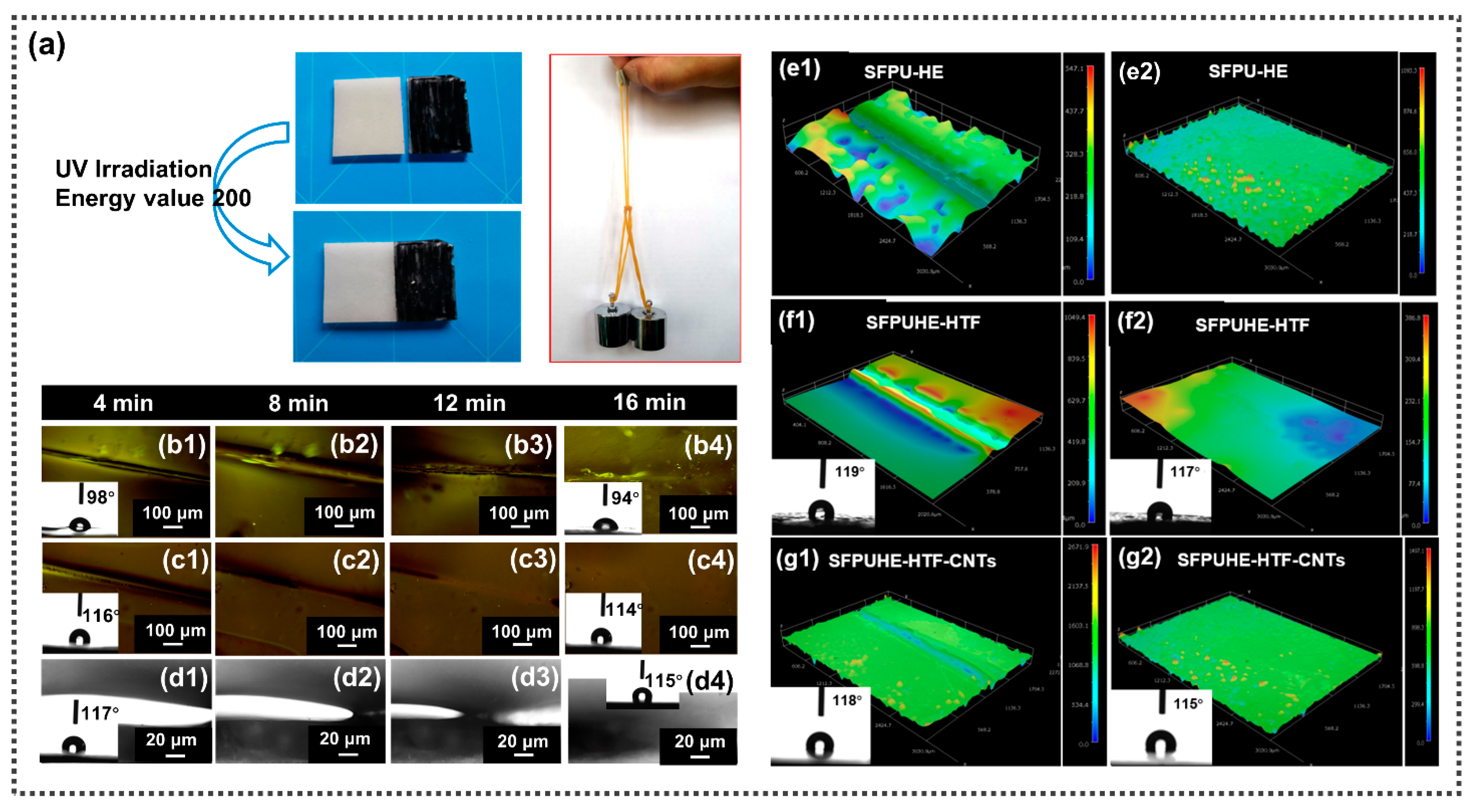
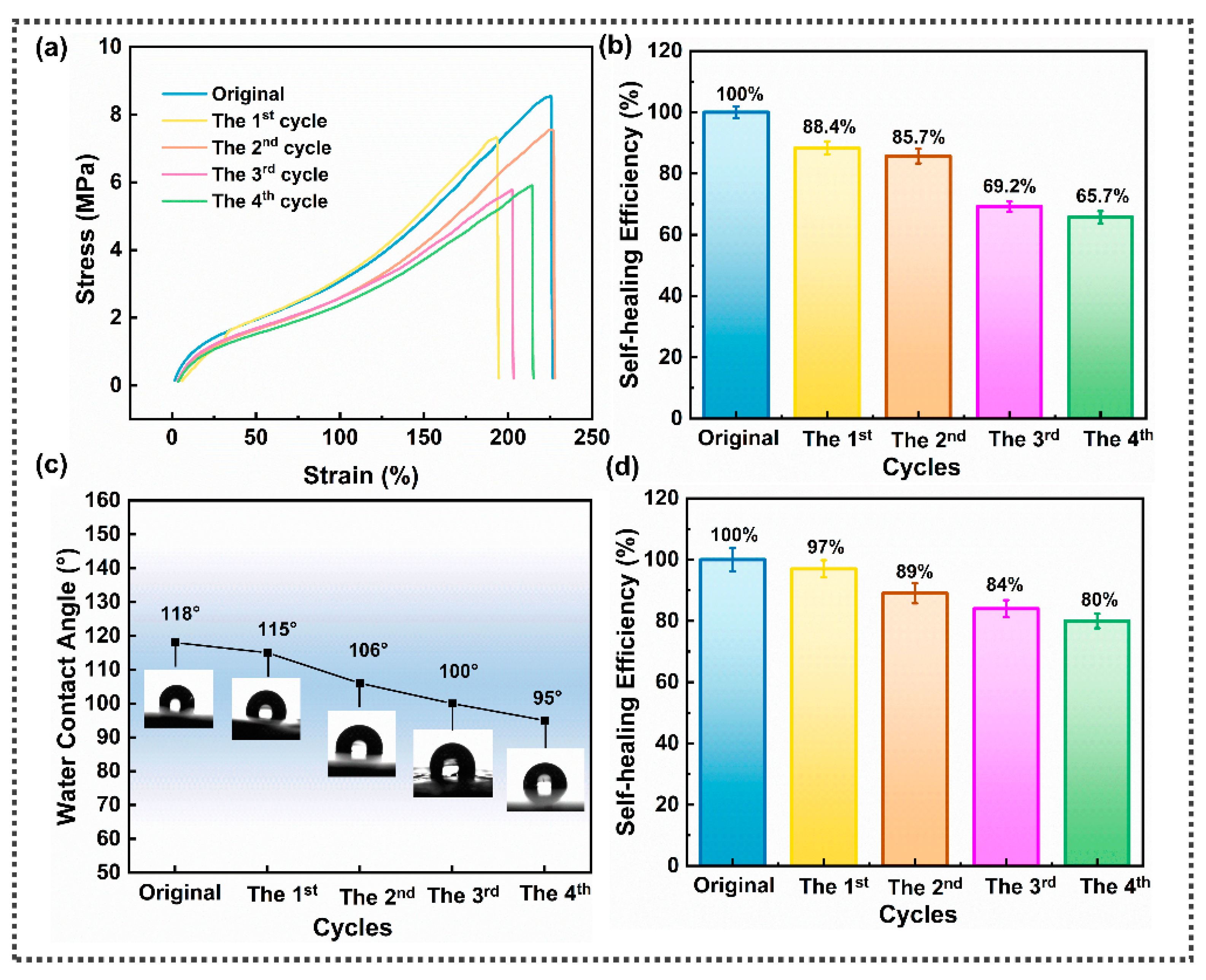
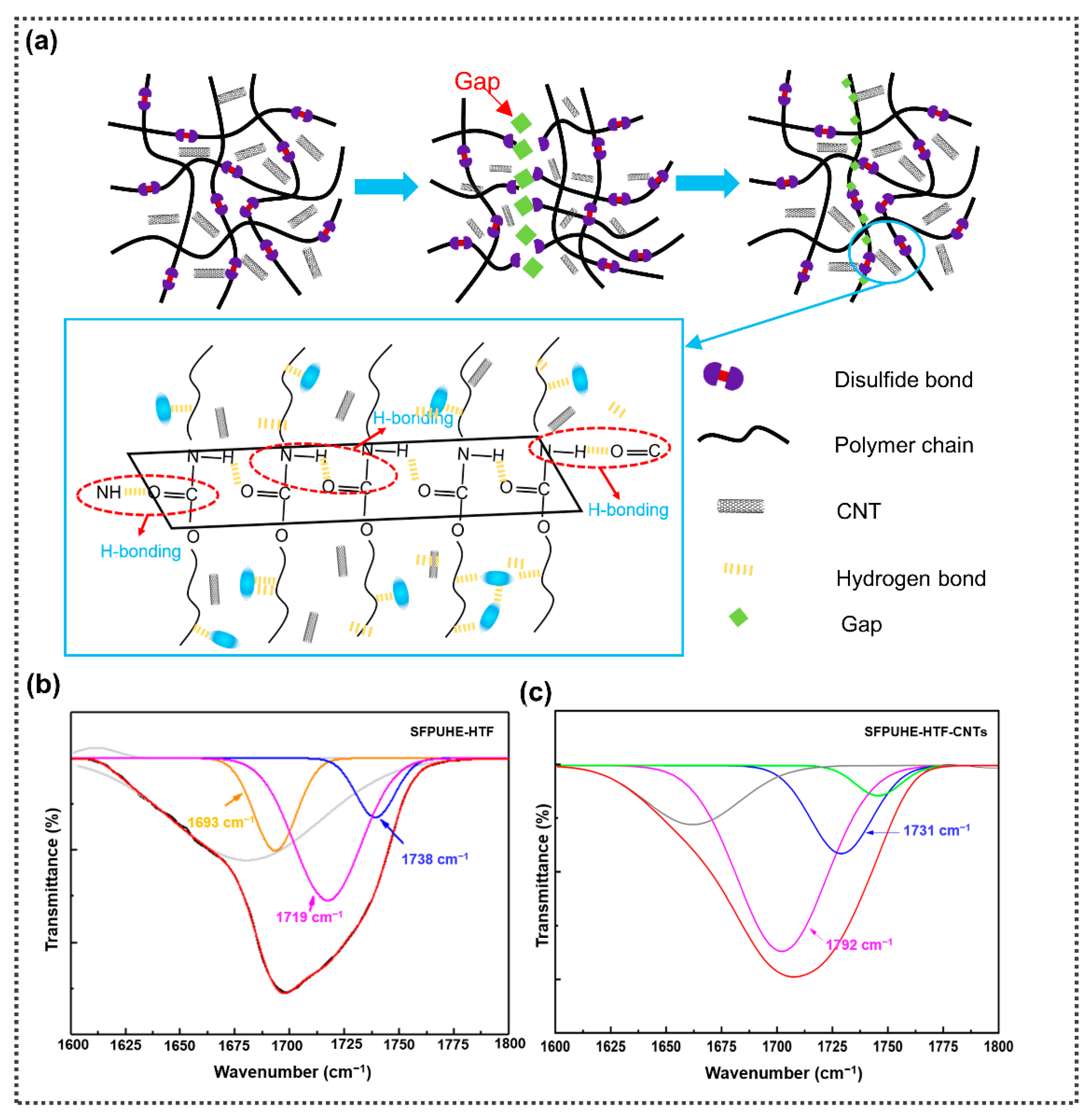
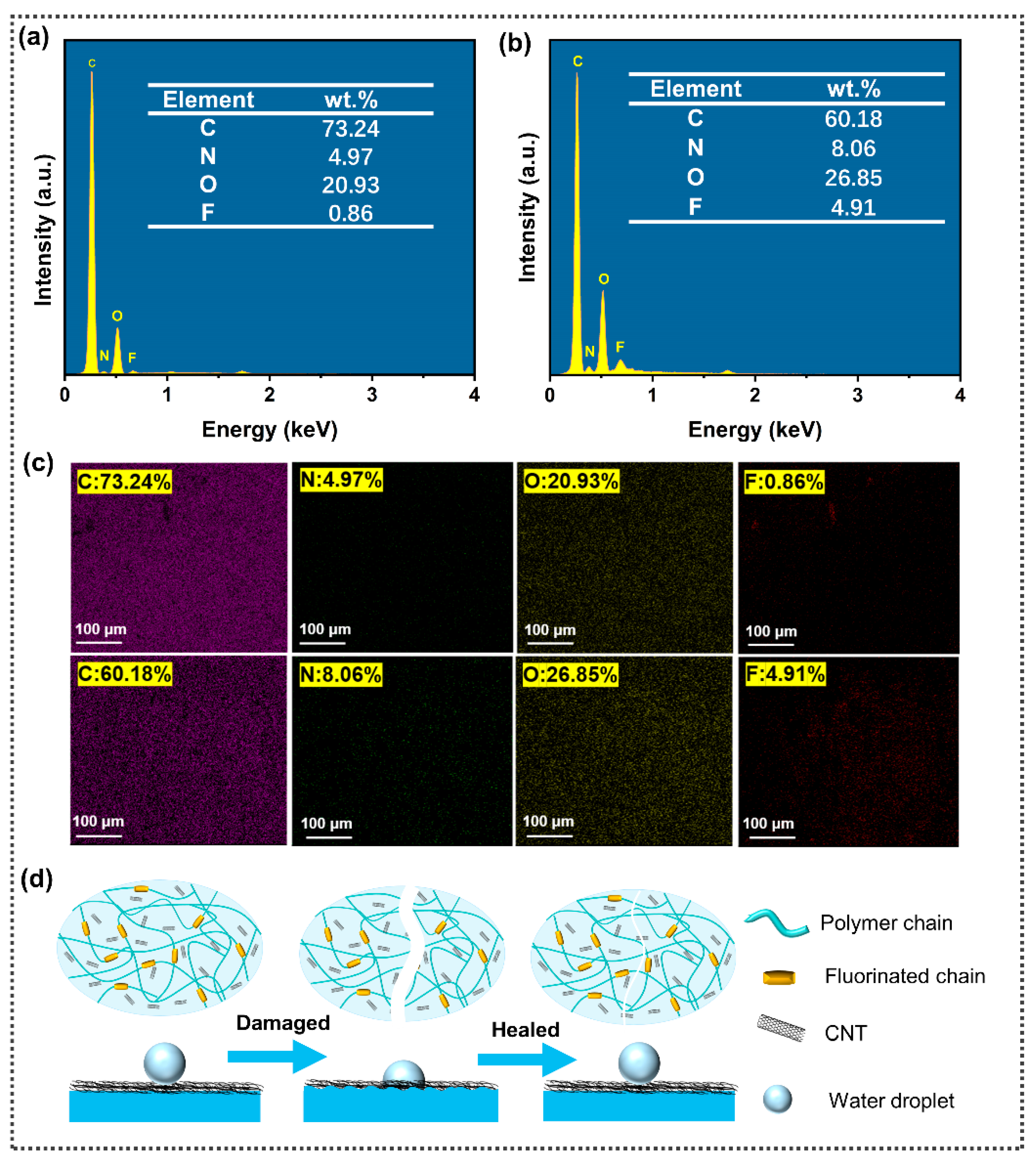
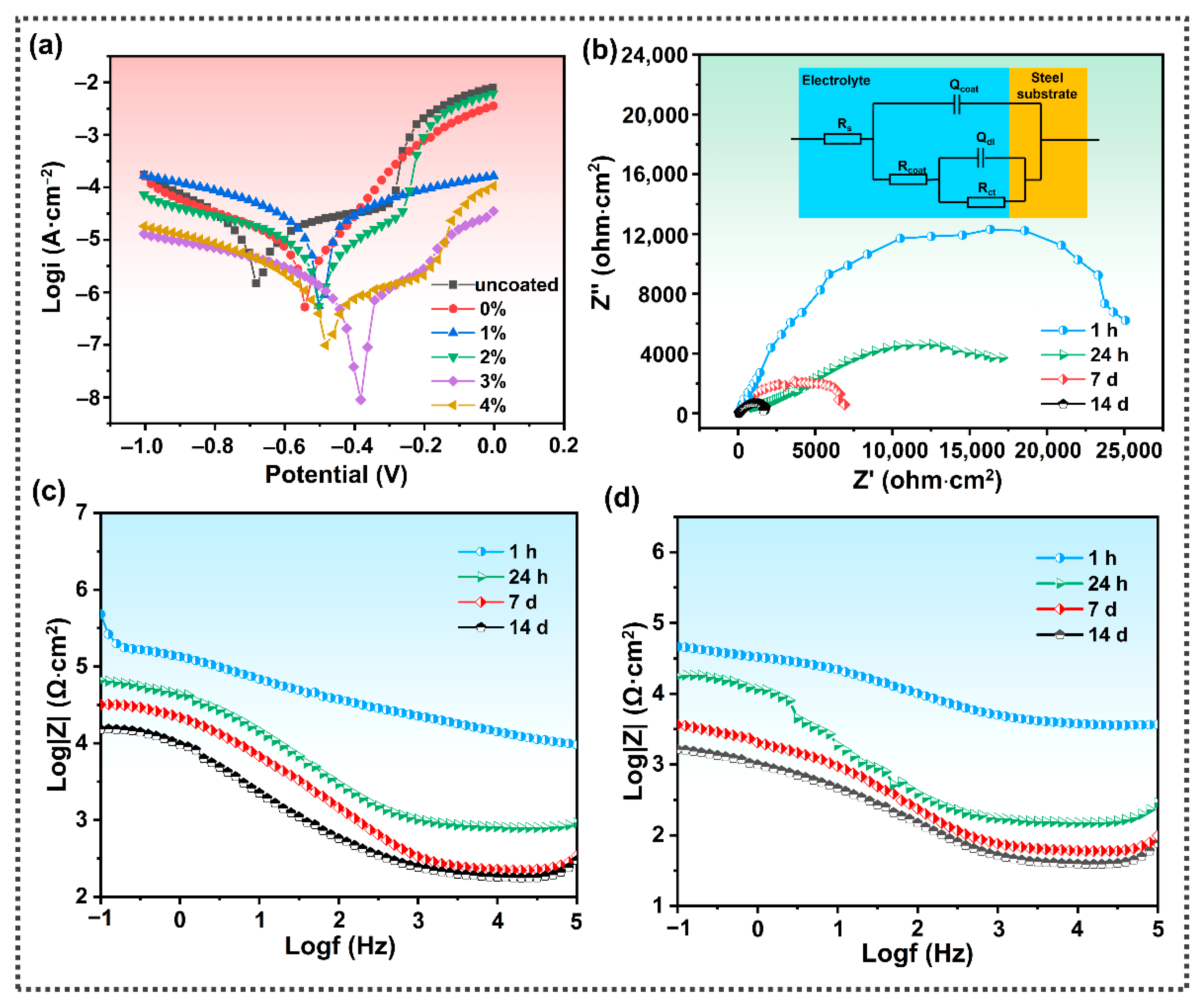
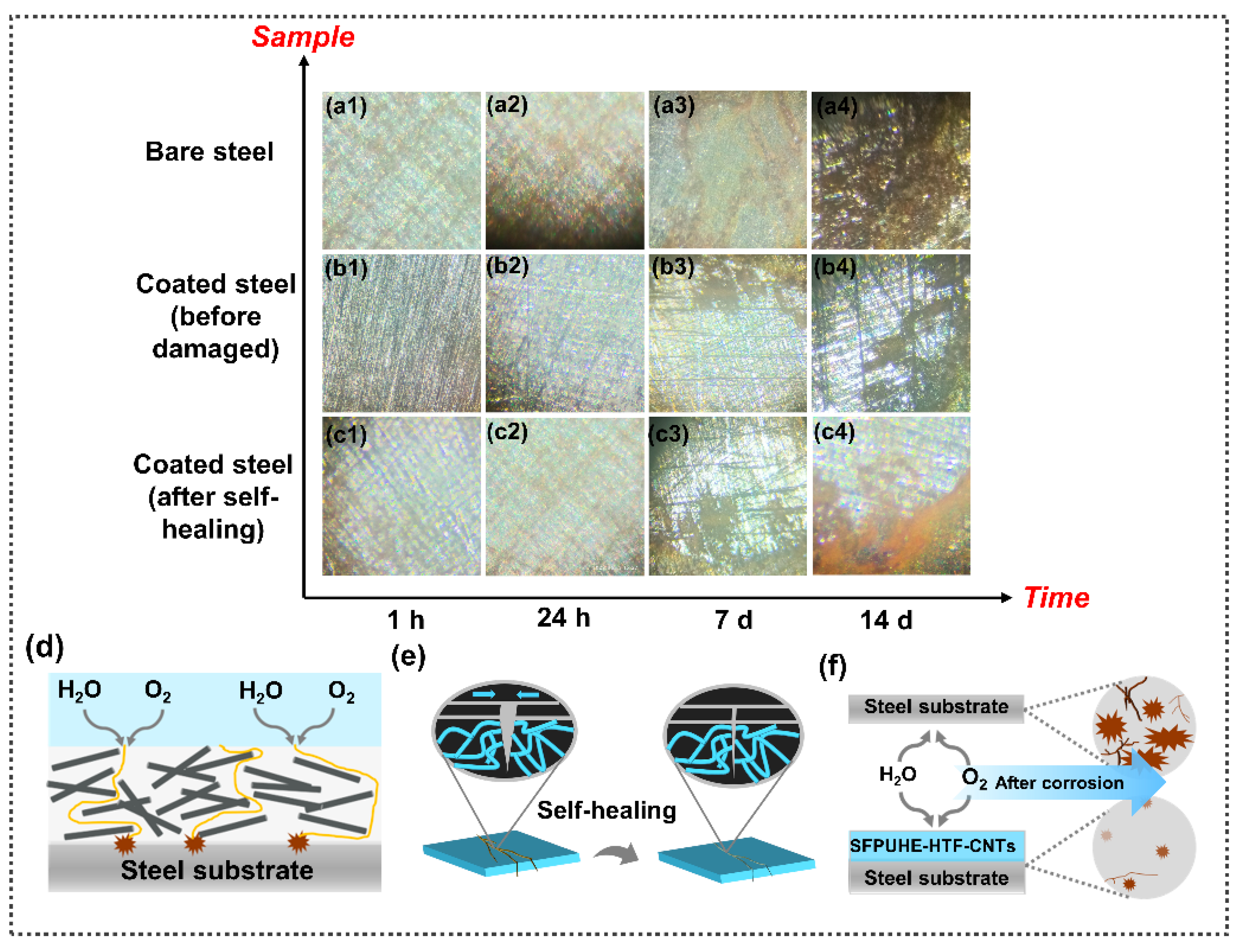
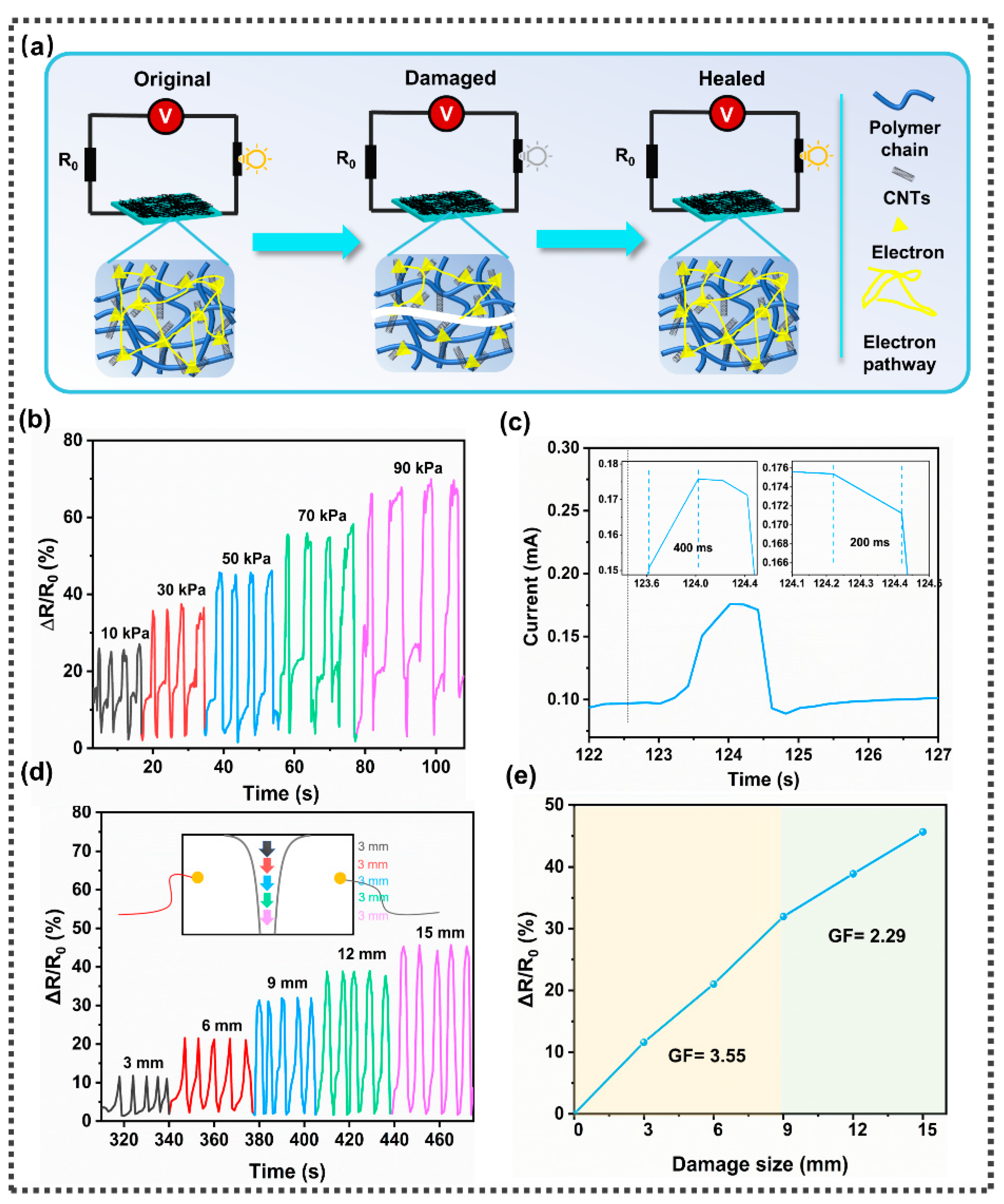
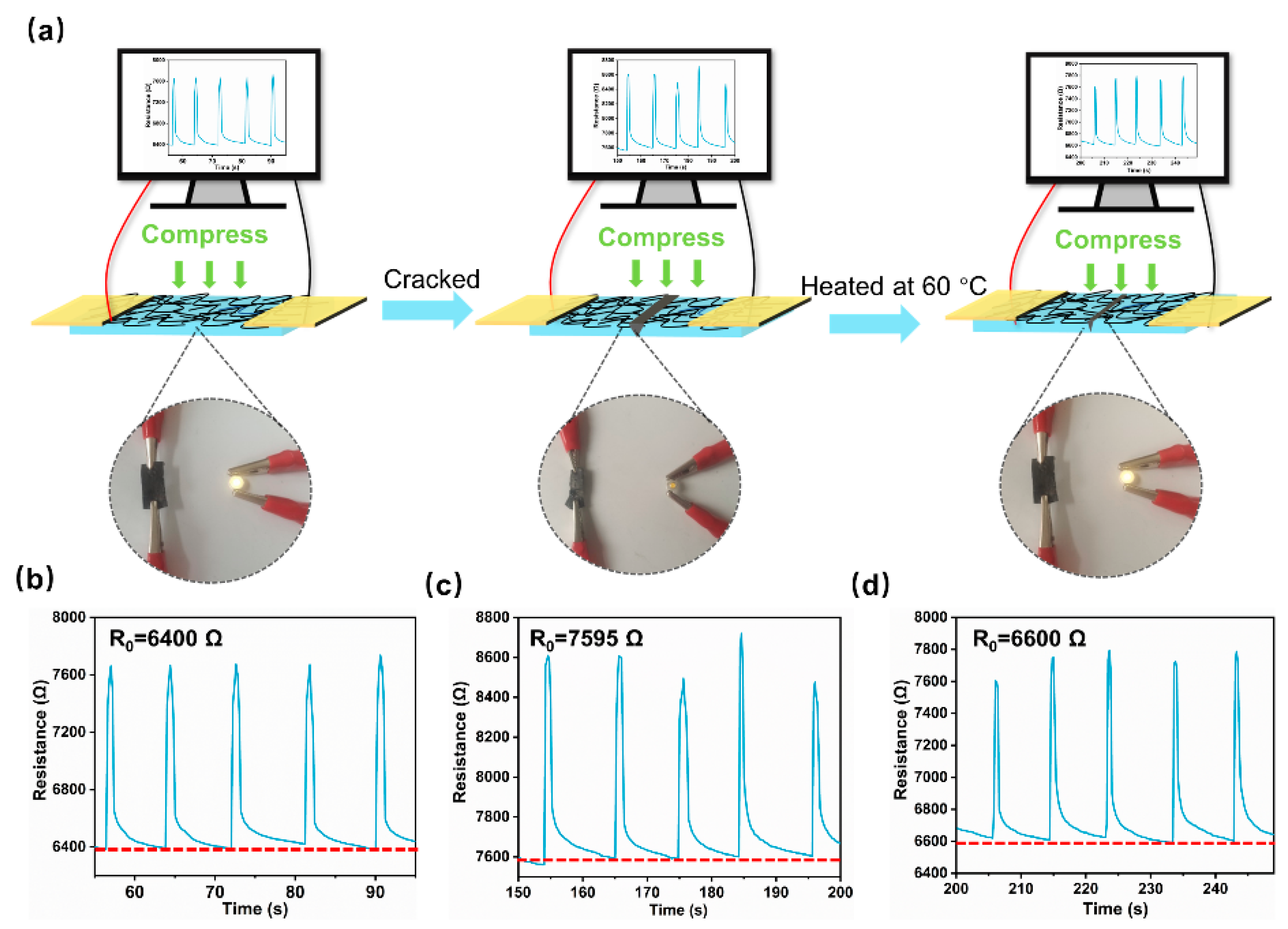
| Sample | Rs (Ω·cm2) | Rct (Ω·cm2) | Qdl (Ω−1·sn·cm−2) | Rcoat (Ω·cm2) | Qcoat (Ω−1·sn·cm−2) |
|---|---|---|---|---|---|
| 1 h | 10.45 | 2.51 × 104 | 5.45 × 10−7 | 4174 | 1.98 × 10−6 |
| 24 h | 11.17 | 1.71 × 104 | 7.55 × 10−7 | 3041 | 4.32 × 10−6 |
| 7 d | 12.32 | 6.91 × 103 | 1.01 × 10−6 | 2382 | 5.91 × 10−6 |
| 14 d | 13.47 | 1.65 × 103 | 1.74 × 10−6 | 1056 | 9.82 × 10−6 |
Disclaimer/Publisher’s Note: The statements, opinions and data contained in all publications are solely those of the individual author(s) and contributor(s) and not of MDPI and/or the editor(s). MDPI and/or the editor(s) disclaim responsibility for any injury to people or property resulting from any ideas, methods, instructions or products referred to in the content. |
© 2022 by the authors. Licensee MDPI, Basel, Switzerland. This article is an open access article distributed under the terms and conditions of the Creative Commons Attribution (CC BY) license (https://creativecommons.org/licenses/by/4.0/).
Share and Cite
Kong, H.; Luo, X.; Zhang, P.; Feng, J.; Li, P.; Hu, W.; Wang, X.; Liu, X. Self-Healing, Solvent-Free, Anti-Corrosion Coating Based on Skin-like Polyurethane/Carbon Nanotubes Composites with Real-Time Damage Monitoring. Nanomaterials 2023, 13, 124. https://doi.org/10.3390/nano13010124
Kong H, Luo X, Zhang P, Feng J, Li P, Hu W, Wang X, Liu X. Self-Healing, Solvent-Free, Anti-Corrosion Coating Based on Skin-like Polyurethane/Carbon Nanotubes Composites with Real-Time Damage Monitoring. Nanomaterials. 2023; 13(1):124. https://doi.org/10.3390/nano13010124
Chicago/Turabian StyleKong, Hui, Xiaomin Luo, Peng Zhang, Jianyan Feng, Pengni Li, Wenjie Hu, Xuechuan Wang, and Xinhua Liu. 2023. "Self-Healing, Solvent-Free, Anti-Corrosion Coating Based on Skin-like Polyurethane/Carbon Nanotubes Composites with Real-Time Damage Monitoring" Nanomaterials 13, no. 1: 124. https://doi.org/10.3390/nano13010124
APA StyleKong, H., Luo, X., Zhang, P., Feng, J., Li, P., Hu, W., Wang, X., & Liu, X. (2023). Self-Healing, Solvent-Free, Anti-Corrosion Coating Based on Skin-like Polyurethane/Carbon Nanotubes Composites with Real-Time Damage Monitoring. Nanomaterials, 13(1), 124. https://doi.org/10.3390/nano13010124





